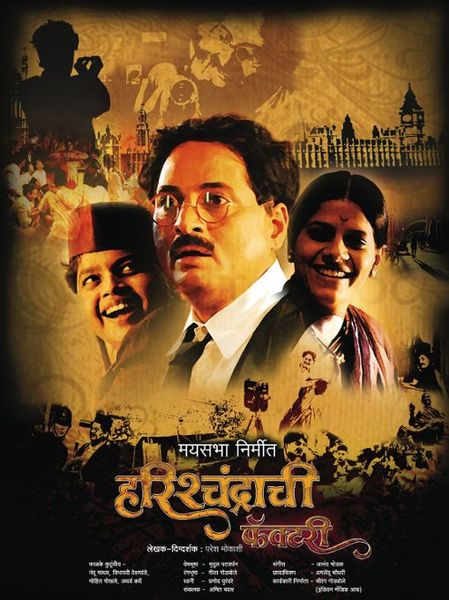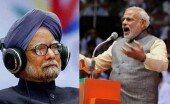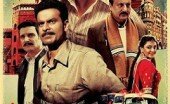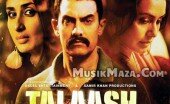Bollywood Begins [Harischandrachi Factory (2009)]
Written by Alok // June 27, 2011 // Media & Popular Culture // 3 Comments
(This film has already been reviewed on C20s in depth and detail by Ankan here. This is to add my two cents on what the film means (or at least ought to mean) to Bollywood and remind you all to catch it on DVD)

India’s regional cinema most often gets swamped by Bollywood’s glitter, glamour and gold. In terms of technical and critical achievement, Bengali, Tamil, Malayalam, Kannada and Marathi films match, and more often than not, outstrip Bollywood. While ostensibly catering to the tastes of a linguistic minority in this country (which usually far outstrips the audience of most other language films), the stories they tell and the techniques they adopt are universal, appealing to an audience wider than the narrow confines of language. Being a Kannada speaker myself, I will happily gush for hours to a non-Kannada audience about the brilliance of Puttanna Kanagal’s movies, Girish Karnad’s thoughtful, but taut scripts, songs featuring the rich and nuanced voice of Dr. Rajkumar (this is heresy, but I think he was a better singer than actor, this notwithstanding), the dazzlingly brilliant, but all too short career of the late Shankar Nag, and the undoubted greatness of Kannada movies that rank alongside the best made in India. No doubt connoisseurs of Bengali, Tamil, Malayali and other regional cinema will do the same. Yet, I am going to recommend to you a Marathi movie as one of the finest made in India in the last couple of decades.inflatable slides
“Harishchandrachi Factory” is the story of how that great pioneer of Indian cinema, Dhundiraj Govind “Dadasaheb” Phalke, made the first Indian movie, Raja Harischandra. Part-biopic, part-comedy and part-movie-about-making-a-movie, but all brilliant, Harischandrachi Factory is a fantastic debut effort by director Paresh Mokashi that will tell you a grand tale with a light touch, bring to life Phalke’s heartbreaking struggle in a manner that never weighs you down and yet, amid all of that, entertain you through and through. Any movie which did that is of course a must-watch, but Harishchandrachi Factory does more.
Harischandrachi Factory is also an “origin story” in the sense that it is the movie about the birth of the behemoth that is Bollywood. It is a tale that is nothing short of inspiring. From having to sell all his furniture (and his wife’s jewellery) to fund the project to having to bail out his cast and crew from the clutches of a suspicious police officer, Phalke does it all without a complaint, with an almost-insane conviction of his success. Even the actual flop of the film on the first day of its release does not deter him. He just invents the concept of post-release marketing. We watch as the lines swell, the crowds flock and the money rolls in at the ticket counters and Bollywood as we know it, is born.
I watched Harishchandrachi Factory many months ago; the last screening of the film at a sparsely filled multiplex audi. Much as I enjoyed the movie, as I walked out of the screening, I couldn’t help but feel a twinge of sadness as I reflected upon its fate at the box office. Clearly, this movie deserved a wider audience and better publicity. True, it swept almost every award in every competition it was entered in, within the country, but as India’s entry for the Best Foreign Film Oscar, it was an orphan abandoned to its fate at the uncaring hands of the Academy of Motion Picture Arts and Sciences. Within the country itself, it played to small audiences, mostly in multiplexes, apart from the Marathi theatres.
To me, this reeks of ingratitude. Star actors and directors, to say nothing of producers and studios, rake in billions but seem to know little of the history or the origin of the industry that has spawned their success. India may have had a film industry without Dadasaheb Phalke, but it is hard to imagine that it would have grown to become the mass media mammoth that it has become without his pioneering vision. Where film may have been seen as an “educative” tool or a primarily a canvas for high art, Phalke envisioned at as being first, and foremost, an entertainment tool, and an industry that employed the skills and talents of hundreds towards commercial success. Perhaps he understood that it was a medium that had the capacity to reach out to an unlettered country, and would cater to an audience that was trying to find its cultural moorings in an increasingly urban environment. His movies, in that sense, aimed at the largest and broadest audience possible; a philosophy that Bollywood followed with great success for the better part of a century, but regrettably, in this millennium, seems to have abandoned in favour of pandering to that insidious demographic, “the multiplex crowd“. (Of course, I am being unduly harsh, but Bollywood’s bent towards the affluent upper middle class is unmistakeable all the same)
It goes without saying that sport and cinema unites Indians in a manner that few other institutions have been able to do so. Our political science professor in college (himself a native Telugu speaker) never ceased to point out that Bollywood did so much more for the promotion of Hindi in South India and East India than any half a dozen Government departments or Government initiatives. Indian cinema could have contented itself with critical acclaim, niche and elite audiences, or just the capture of linguistic markets. Yet Bollywood, warts and all, is something akin to a national cultural product, precisely because of its ability to cut across barriers of language and appeal to the widest possible audience, within and without India. Its success is not the prerogative of the actors, big or small, directors, producers, distributors or the audience. Its success is the greater than the sum of its parts, and much of it, owes to the initial vision of Dadasaheb Phalke as he took great risks and sacrificed much to make Raja Harishchandra.
And yet, and yet; he is forgotten so easily. True, a national award for life-long contribution to cinema is named after him, and rightly so, but it tells us little of the struggle, the vision or the man. It should a matter of great national pain that there are no remaining prints of Raja Harishchandra, destroyed as the last remaining one was by a fire that seems to be the hallmark of the callousness with which history is “preserved” in this country. There is not even a single photo or still from that great film.
And when a Marathi movie is made to remember the progenitor of Bollywood, what is the collective reaction of his scions in cinema? Indifference. And silence.
Still, it is no reason to lose heart entirely. The film is out on DVD (it’s available online on Flipkart as well) and if you were not one of the fortunate few to have caught it in the theatre, you can still enjoy this delightful film in the comforts of your home and reflect upon the journey that Bollywood’s made.





3 Comments on "Bollywood Begins [Harischandrachi Factory (2009)]"
If you remember our post-movie discussion, what we/I loved most was that the movie was made in the style of old movies, with that typical sad/happy instrumental track. I was personally swept back to the time of Sunday evening-DD movie days. And that’s something that’s such a personal and cultural thing that it is impossible for a foreign crowd or even a younger crowd to understand.
I suppose the film-makers could’ve easily made it in foreign award bait format, but I’m so glad they didn’t. Sure, this means it got relegated to UTV World Movies please-change-the-channel category, but I think the film-maker managed to realize all his ideas and made the movie exactly the way it was supposed to be, so anonymity is a small price.
Oh absolutely agree. It was completely not Award bait. It didn’t feature Nazis for heaven’s sake!
But no, even if it didn’t mean to try and capture Oscar eyeballs, I would have liked to see Bollywood at least make the effort; you know, sort of be a little bit less of the supremely entitled, navel gazing, gossip obsessed, and phenomenally obnoxious prima donnas we know them to be.
r u sure that’s accurate?
my web page catering Toronto